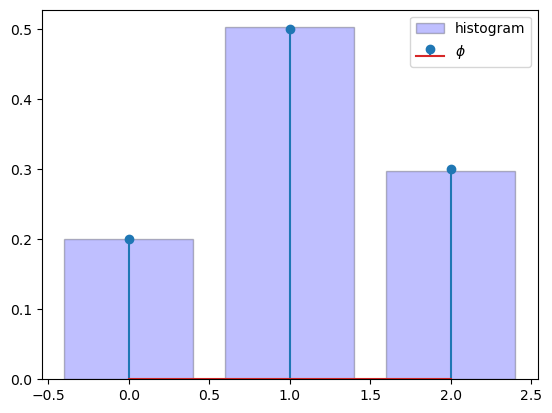Chapter 2 Code#
We’ll use Python’s NumPy library in what follows, as well as Matplotlib for plotting.
import numpy as np
import matplotlib.pyplot as plt
Bisection#
Here’s an implementation of the bisection algorithm. We will test it on this function:
f = lambda x: np.sin(4 * (x - 1/4)) + x + x**20 - 1
The implementation:
M = 1000
ϵ = 1e-8
α, β = 0, 1
i = 1
a, b = α, β
while i <= M:
c = (a + b) / 2
if abs(f(c)) < ϵ:
print(c)
break
i += 1
if f(a) * f(c) < 0:
b = c
else:
a = c
if i > M:
print("Failed to converge.")
0.408293504267931
User Defined Functions#
Here’s the basic implementation of the function \(\tau\).
def tau(z, S, phi):
"""
Evaluates the function tau(z) given data S, phi, where
S and phi are assumed to be arrays.
"""
a = 0
for i, x in enumerate(S):
b = a + phi[i]
if a < z <= b:
return x
a = b
Here’s a more efficient implementation.
def tau(z, S, phi):
i = np.searchsorted(np.cumsum(phi), z)
return S[i]
And here’s a closure that generates the function \(\tau\).
def tau_factory(S, phi):
Φ = np.cumsum(phi)
def tau(z):
i = np.searchsorted(Φ, z)
return S[i]
return tau
We generate a function \(\tau\) that acts on \(z\) alone by calling the function factory:
phi = 0.2, 0.5, 0.3
S = 0, 1, 2
tau = tau_factory(S, phi)
tau(0.1) # Should be 0
0
All of these functions work as expected. To illustrate, here \(\tau\) is used to generate draws from a given distribution \(\phi\).
size = 100_000
draws = np.empty(size)
for j in range(size):
W = np.random.uniform()
draws[j] = tau(W)
# Compute fraction of draws with each possible value
frequency = [np.mean(draws==j) for j in S]
Let’s check that the empirical frequency approximately coincides with the probabilities in \(\phi\).
fig, ax = plt.subplots()
ax.bar(S, frequency,
edgecolor='k',
facecolor='b',
alpha=0.25,
label="histogram")
ax.stem(S, phi, label='$\\phi$')
ax.legend()
plt.show()

Object Oriented Programming#
Here’s a class that implements the function \(\tau\) as a method, as well as a method to generate draws from \(\phi\).
class Tau:
def __init__(self, S, phi):
self.S = S
self.Φ = np.cumsum(phi)
def tau(self, z):
i = np.searchsorted(self.Φ, z)
return self.S[i]
def draw(self):
W = np.random.uniform()
return self.tau(W)
tau = Tau(S, phi)
for i in range(5):
print(tau.draw())
0
2
0
0
1
